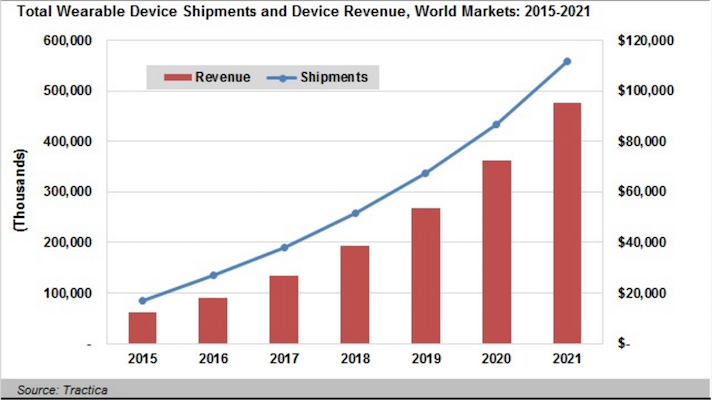 A new crop of research reports are predicting the ways in which the market for wearable devices, including smartwatches and activity trackers, will change over the next few years.
A new crop of research reports are predicting the ways in which the market for wearable devices, including smartwatches and activity trackers, will change over the next few years.
Tractica predicts that annual wearable device shipments will increase from 85 million units in 2015 to 559.6 million units by 2021, representing a compound annual growth rate (CAGR) of 36.9 percent. ABI Research predicts shipments of just activity trackers will top 87 million in 2021.
Tractica said that they adjusted their prediction upwards from previous years for a number of reasons. They said fitness trackers had stronger than expected growth and the market wasn't as cannibalized by the smartwatch market as expected either. In addition, they cited "a proliferation of smartwatch offerings, including not just high-end watches such as Apple Watch and Android Wear offerings, but also the incorporation of smart capabilities in more conventional products from traditional watchmakers". Finally, rapid development of body sensors, smart clothing, wearable cameras, smart glasses, and various niche devices is driving the market, Tractica reported.
“2015 was the biggest year for wearables by far, with fitness trackers outperforming industry expectations and smart watches coming out strong,” research director Aditya Kaul said in a statement. “While fitness is the overwhelming driver for wearables today, there are a number of micro-segments emerging, ranging from kids’ watches to smart footwear to new healthcare devices like wearable patches, that will drive this market forward.”
In addition to its market predictions, ABI surveyed 300 consumers about their interest in getting a smartwatch.
Thirty-five percent of respondents said they were considering buying a smartwatch in the next 12 months. And more than 80 percent said their primary reason for not buying a smartwatch was the belief that smartphones can adequately address all necessary tasks. Just 24 percent of those who expressed interest in purchasing a smartwatch were willing to pay more than $300, even though the average selling price of a smart watch in 2015 was $316, according to ABI's analysis.
“Most consumers remain under the impression that a smart watch is a smartphone accessory rather than an independent device,” David McQueen, Research Director at ABI, said in a statement. “Though market growth is slow, the smartwatch will gain attention in due time if manufacturers focus on strategically branding the smartwatch to differentiate it from a smartphone.”
Finally, Technavio said the global fitness tracker industrial market is expected to exceed $587 million by 2019, growing at a CAGR of over 66 percent. The market's growth would be driven by employee wellness programs (we've reached out to clarify whether the $587 million projection is for all employee wellness companies or just industrial ones.) Technavio singled out the top six vendors contributing to the global industrial wearable devices market: Apple, Epson, Fujitsu, Google, Microsoft, and Vuzix.


















